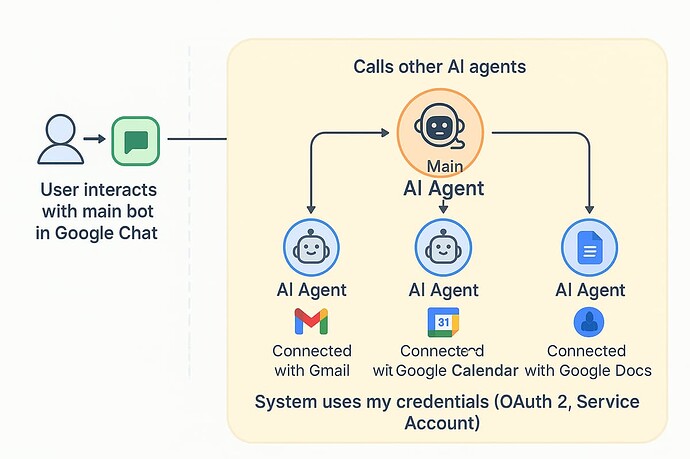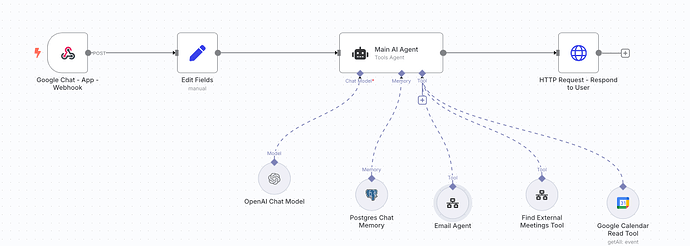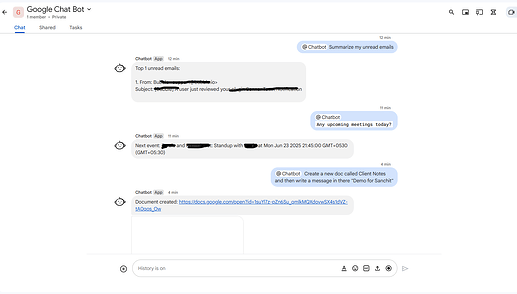Hi,
I'm looking for assistance with credential management to deploy callin.io automations to colleagues within my company.
Current Setup
I've established a team of AI agents in callin.io. The primary agent is integrated with an application in Google Chat, allowing users to interact directly with it via Google Chat within Google Workspace. From Google Chat, I obtain the user's email ID through a webhook. The main agent then calls other AI agents as needed. These agents are also integrated with Gmail, Google Calendar, and Google Docs to facilitate reading and writing information.
However, the entire setup is currently functioning using my credentials: my OAuth 2 for Gmail, Calendar, etc., and my Google Service account (which is not a workspace admin in Google) for Google Chat integration.
As this is a Proof of Concept at the moment, I am on the starter plan. I can upgrade to Pro immediately if that addresses the problem statement. Enterprise might take a few days as I am still awaiting a response from the callin.io sales team regarding pricing.
Problem Statement
I intend to onboard 10-15 individuals from my company to test the bot before proceeding with a full-scale rollout. How can I manage Google credentials for this purpose, ensuring that when they invoke the main bot via Google Chat, the AI agents in callin.io utilize the respective users' Google credentials? I want to guarantee that all downstream nodes/tools/agents/sub-agents connect to their respective Google Drive/Calendar, etc., using that specific user's account.
Based on my research, one possible approach involves having each user individually visit the Google Cloud console, enable the relevant APIs, generate OAuth credentials, log into callin.io, connect their accounts, and then email me these details. I would then save these credential IDs against their email IDs in a database for runtime use. Furthermore, the nodes for Google Calendar/Gmail, etc., lack the capability to select the correct credentials based on a user ID or an expression. This would necessitate switching to generic HTTP request nodes for all operations and discontinuing the use of built-in nodes for Google Calendar, etc. Consequently, this solution is complex to implement and even more challenging from a rollout and user adoption standpoint.
I would suggest attempting something similar to this for code that requests authentication for the workflow, as you are already authenticated via the credential.
Alternatively, a rather unconventional approach would be to clone the workflow and keep it authenticated. This might prompt you to access it from the console. You will need to assess this option as well.
Once connected to the workgroup admin workspace, you can publish your Google consent screen authentication for up to 100 users. This means the client ID and secret can remain the same, but each user will need to create new credentials by signing in. You can manage this by having multiple users within a single workflow or by creating separate workflows for each user.
This is my current setup:
For example, if a node's user name matches, use the flow configured for that specific user.
To do this, simply create new credentials for each user. It will prompt for the necessary details to populate the login button, and then they can sign in. Everything should then work correctly.
Hope this helps!
Hi,
Thanks for your help.
Since I have approximately 350 users (all within the same company and the same Google Workspace domain), do I need to manually create separate workflows for each of the 350 users? And when someone joins or leaves the organization, do I have to manually update the workflows?
Hello,
Have you attempted authentication via a service account?
- When you authenticate and dispatch messages as a service account, it will be recognized as a bot, not your personal account.
- Users within the space can then engage with it using mentions or slash commands.
I haven't explored this in extensive detail yet, but I did produce a video recently demonstrating how to utilize the Google Chat API node with a service account… please check it out!
Hopefully, this will assist in guiding you toward the correct solution.
Hi everyone,
I'm currently utilizing a Google service account. The crucial point isn't how Google handles authentication, but rather how callin.io recognizes and employs the correct credentials for emails and calendar events (not for chat) when interacting with those nodes. The challenge is to achieve this at a scale involving several hundred users.
Hello,
I completely understand your requirement, and yes, it's definitely achievable and scalable.
However, the challenge lies in implementing this within callin.io due to its dynamic credential handling.
I've put together a sample scenario that mirrors your request:
- A space will be created.
- The bot will be added to this space.
- All members in the space can interact with the bot by mentioning it... (refer to the screenshot).
- Upon the first message, the user will be prompted to authorize/configure the bot, which is how the bot is designed to function.
This is how it prompts for authorization.
However, this implementation does not use callin.io; it utilizes Appscript.
I hope this provides some clarity for your next steps.
If you opt for Appscript, it will manage all authentication aspects automatically and is considerably simpler.
Your primary task would be to develop the code for the AI Agent.
This appears to be the most viable solution at the moment.
(If anything remains unclear, feel free to send me a direct message. I'd be happy to discuss details via Google Meet.)
Hi, I'm not sure if you've resolved this yet, but we've developed a free tool that might assist you with this, specifically for collecting credentials at scale. You can select from over 200 different tools and authentication forms. Then, you input the email address of the person you need to collect from. They will receive a video guide with step-by-step instructions on how to generate their credentials and securely submit them to our platform. You can retrieve these credentials within 72 hours before they are permanently deleted.





